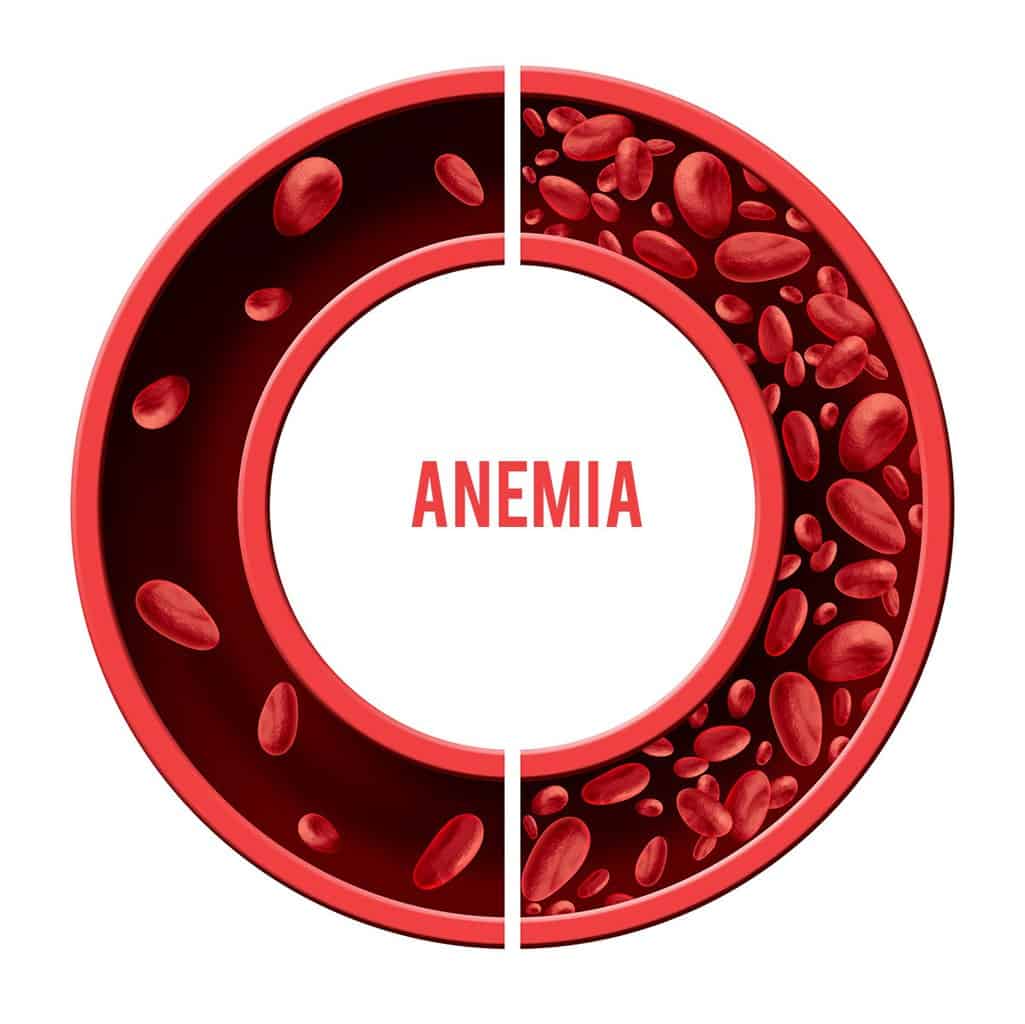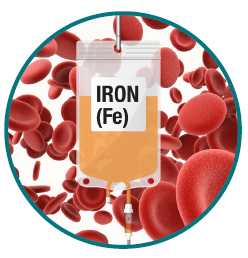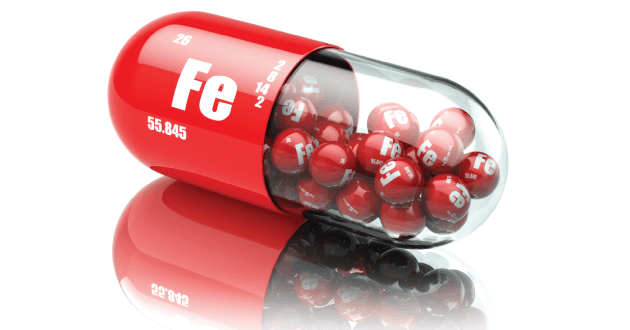Importance of iron
Iron is essential in many biological processes, including erythropoiesis, oxidative metabolism, energy generation, and in the body’s immune responses. Most of the iron in the body (~65%) is incorporated into haemoglobin (Hb) for oxygen transport. A smaller proportion (~10%) is present in myoglobin, cellular enzymes, and cytochromes. The remainder is stored in the hepatocytes of the liver, and in the macrophages of the reticuloendothelial system (RES). Particularly in the bone marrow, spleen, and liver.
How iron is lost?
Under physiological conditions, iron is lost on a daily basis, through the shedding of intestinal cells. Iron is also lost from the body through menstruation and blood losses, such as pathological intestinal bleeding. Daily absorption of 1–2 mg of iron from the gut maintains iron homeostasis under a fine balance. Should this balance be disrupted by increased iron requirements, limited external supply of iron, reduced iron absorption, or by greater iron losses, iron deficiency may result.
Iron deficiency is considered to be the leading cause of anaemia, which is defined as an Hb level.
When there is a lack of iron, it is reflected in the production of hemoglobin and red blood cells (erythrocytes). Insufficient production of hemoglobin results in insufficient supply of cells and tissues with oxygen and the development of anemia. Although there are a large number of types of anemia, iron deficiency anemia is by far the most common. The clinical consequences of iron deficiency are great.

The aim of treatment for iron deficiency is to supply enough iron to replenish iron stores and normalize haemoglobin concentration in anaemic patients.
Symptoms of iron deficiency
- fatigue
- lack of energy
- headache
- dizziness
- painful menstruation
- increased hair loss
- pale discoloration of the skin and mucous membranes
- dry, damaged hair and dry skin
- shortness of breath during exercise
- rapid heartbeat, palpitations
- unreasonable anxiety and low mood
As the anemia worsens, the consequences can become more serious and individuals may experience:
- neurological impairment
- arrhythmias
- potentially even heart failure
Consequently, the diagnosis and treatment of IDA should be a priority. IDA is a frequent consequence of different diseases or interventions that disrupt iron homeostasis.
Treatment of iron deficiency anemia
Treatment of iron deficiency and iron deficiency anemia includes three main options:
- Oral iron
- Parenteral iron supplementation
- Blood transfusion
Oral iron
Oral iron is the first line therapy in most patients and is effective in many cases. However, there are also many patients who fail on oral iron therapy, either due to lack of efficacy or lack of tolerability.
In 25-50% of patients, gastrointestinal (GI) adverse reactions cause the patient to stop treatment. In addition, the absorption of iron from the GI tract is blocked in a number of conditions, e.g., inflammation, lack of acid production in the stomach either due to gastritis or PPI use, and bariatric surgery where the duodenum has been bypassed. Even under optimal conditions, the GI absorption is limited to 10-20 mg iron per day, meaning that 3-6 months of treatment is often necessary for iron repletion with oral iron. This poses a major compliance issue, even in patients tolerating and absorbing oral iron.
Parenteral iron treatments
Parenteral iron includes preparations for infusion intravenously (IV) or injection intramuscularly (IM). Intramuscular injection is not recommended by most experts, due to dose limitations, pain involved, and risk of staining. Therefore, only IV iron formulations are referred to here.
There are six main types of IV iron compounds available globally:
- iron sucrose
- ferric gluconate
- ferric carboxymaltose
- iron isomaltoside
- ferumoxytol
- iron dextran

These iron compounds are typically comprised of an iron containing a core surrounded by a carbohydrate shell. This iron-carbohydrate entity forms a nanoparticle. The characteristics of the iron compound are therefore not only dependent on the iron and the carbohydrate content, but also on the characteristics of the nanoparticle, such as particle size and stability. This is also why it is very difficult to produce generic versions of existing compounds. The first IV irons were administered as iron salts. These compounds were highly toxic due to the release of free iron in the blood stream. Free iron (often referred to as labile iron) is highly toxic and causes immediate dose-dependent toxicity in the form of hypotension and nausea. In addition, there is a potential for long-term toxicity due to endothelial damage causing cardiovascular disease. To limit free iron toxicity, iron was coupled to a carbohydrate to form iron-carbohydrate complexes.
Previous iron-carbohydrate complexes
The first iron-carbohydrate complexes often caused serious hypersensitivity reactions, which limited their use.
With newer compounds, that risk has been reduced significantly. Still, the risk of serious hypersensitivity reactions and free iron release from iron-carbohydrate complexes are the main determining factors for the different compound’ s safety, convenience, and cost-effectiveness profiles. Compounds that are loosely bound, such as iron gluconate and iron sucrose, can only be administered in small single doses. Otherwise, symptoms of free iron toxicity occur. This has a huge impact on convenience and cost-effectiveness, as patients have to come for multiple visits to achieve the iron repletion they need. Immunogenicity of the compounds may limit the speed of administration, requiring some compounds to be administered over long periods of time and/or in limited doses. Hypophosphatemia (decreased levels of phosphate in the blood) is emerging as a new important complication to IV iron therapy that differentiates IV iron compounds.
Hypophosphatemia is most frequently seen with ferric carboxymaltose (FCM) (40-70% of patients without CKD) and is thought to be caused by urinary phosphate wasting brought on by the compound. FCM may induce profound hypophosphatemia with potential shortterm symptoms (including fatigue, muscle weakness and bone pain) and long-term consequences, such as osteomalacia and bone fractures. The efficacy of parenteral iron compounds is determined by the amount of iron given, i.e., mg for mg iron, the efficacy is the same. However, the amount of iron that can be given in a single administration varies significantly among the different preparations. This difference s likely to explain the variation in efficacy seen in some head-to-head studies with different IV irons.
Blood transfusion
While blood transfusions have saved the lives of thousands of people, there remains many inherent associated risks. These can include serious infections, serious hypersensitivity reactions, and a negative impact on the immune system. In addition, blood transfusions are very costly as blood is a limited resource and transfusions require extensive lab tests. In several countries, there has been pressure to reduce the number of blood transfusions, with initiatives under the Patient Blood Management umbrella. This includes treating anaemia prior to surgery, potentially with parenteral iron, in order to minimize the need for a blood transfusion during or after surgery.

I am anemic and I have to have a surgery intervention
Anaemia is a complication that can be encountered at several stages of surgical practice – frequently as a result of iron deficiency. Pre-operative anaemia is common; a retrospective analysis reported anaemia in more than one third of patients undergoing a range of standard, major, and elective procedures. Multiple studies have shown that pre-operative anaemia is associated with poorer outcomes, including a longer hospital stay, an increased likelihood of requiring a blood transfusion, and a greater risk of mortality. In addition, significant blood loss during surgery, or slow bleeding after surgery, can lead to the development or worsening of anaemia in the post-operative period.
In general, it is recommended that patients are assessed for anaemia 3–8 weeks (or as early as possible) before surgery, to allow sufficient time for the investigation and management of anaemia before the surgery is performed. Assessment of patients for anaemia in the post-operative period is also recommended. Overall, it is agreed that the correction of iron deficiency with/without anaemia could improve outcomes in surgical patients.
Oral iron is frequently recommended for the correction of IDA before surgery. IV iron is indicated in the pre-operative setting for particular patient groups, such as those who are intolerant to oral iron, or when there is a short time-period between anaemia diagnosis and surgery. However, after surgery, inflammation can elevate hepcidin levels, which impairs the absorption of iron from the gut, rendering oral iron ineffective. Therefore, most guidelines recommend IV iron in place of oral iron for the correction of IDA after surgery.
Anemia in pregnancy
Globally, anaemia is more prevalent in women than men, and iron deficiency is the most frequent cause of anaemia. IDA can occur during pregnancy, in the post-partum period, and in non-pregnant women (mainly as a consequence of heavy uterine bleeding [HUB]). Pregnancy Anaemia is one of the most common complications of pregnancy. Iron requirements rise considerably during the second and third trimesters of pregnancy, due to the expansion of the red blood cell (RBC) mass, and the increased transfer of iron to placental structures and the foetus.
Depending on the severity, IDA is a major risk factor in maternal and foetal morbidity. Alongside common symptoms of anaemia (such as fatigue and headaches), IDA during pregnancy increases the likelihood of a mother requiring a blood transfusion if she experiences blood loss during delivery. Severe anaemia during pregnancy (which may result from dietary iron deficiency) has also been associated with an increased risk of maternal mortality. Furthermore, maternal IDA presents risks to the foetus, including premature birth, low birth weight, and reduced neonatal iron stores.
Guidelines by NATA for patient blood management in obstetrics recommend screening for anaemia during pregnancy, and advise that, if possible, anaemia should be corrected prior to delivery. Oral iron is recommended as the first-line treatment for IDA in pregnant women. Currently, it is advised that treatment with IV iron should be confined to the second or third trimesters of pregnancy, and to particular groups of pregnant women: those with severe IDA; those with newly diagnosed IDA (>34 weeks gestation); and those who are intolerant of, or fail to respond to, oral iron.
Post-partum anaemia
Post-partum anaemia is observed in up to 30% of women, with blood loss during delivery being a contributing factor, irrespective of mode of delivery. An iron deficit during pregnancy, and loss of iron in breast milk in the post-partum period, can also deplete a woman’s iron stores. IDA can have a significant impact on a woman’s health in the post-partum period, and has been associated with lactation failure, lethargy, and post-natal depression. NATA guidelines for patient blood management in obstetrics recommend screening for anaemia after delivery.
Oral iron is recommended as the first-line treatment of post-partum IDA, but IV iron is recommended for women who are intolerant of, or fail to respond to, oral iron. Heavy uterine bleeding HUB has been reported to affect 27% of pre-menopausal women, and depletes iron stores over time, ultimately leading to IDA.
A European survey reported that 63% of women had been diagnosed with iron deficiency at least once during their reproductive years. The women who had been diagnosed with iron deficiency commonly reported fatigue, weakness, paleness, and headaches.
However, clinical studies have shown that iron supplementation – particularly with high-dose IV iron – replenished iron stores, and improved quality of life in women with IDA caused by HUB.
Gastroenterology
Outside of the gut, anaemia is the most common complication of inflammatory bowel disease (IBD). The reported prevalence of anaemia in an IBD patient population ranges from 6–74%, and it is most commonly due to iron deficiency and chronic disease. Iron deficiency in patients with IBD may result from continual blood loss from the ulcerated bowel mucosa, or from impaired absorption of dietary iron.
Additionally, the increased production of inflammatory cytokines in patients with active disease may elevate hepcidin levels. Hepcidin can cause iron deficiency by impairing the absorption of iron from the gut, and by preventing iron export from macrophages; these mechanisms combined can lead to anaemia. The development of anaemia can have a significant impact on patients with IBD, affecting their physical, emotional and cognitive function, and their ability to work. Anaemia in IBD can also lead to hospitalization and increased healthcare costs. In patients with a diagnosis of IDA, iron supplementation is recommended, with the goal of replenishing iron stores and increasing Hb levels. Intravenous (IV) iron therapy is recommended as a first-line treatment for IDA in patients who have clinically active IBD, a previous intolerance to oral iron, or Hb levels <10g/dL.
Oncology
Iron deficiency and anaemia are frequently observed in patients with cancer. A survey of patients with solid tumours or haematological malignancies reported that 33.3% had anaemia and that 42.6% had iron deficiency. In patients with cancer, iron homeostasis can be disrupted by elevated levels of inflammatory cytokines caused by the underlying malignancy and/or by chemotherapy. In cancer patients, anaemia and its primary symptom – fatigue – can have a considerable impact on quality of life.
Cardiology
An international analysis of patients with chronic HF (CHF) found that 50.0% were iron-deficient, and that 28.3% were anemic. Iron deficiency in HF patients has been associated with a poor prognosis. IV iron administration may improve quality of life, physical ability, and reduce the risk of hospitalization in HF patients.
Nephrology
IDA is a common complication in patients with chronic kidney disease (CKD). Anaemia is associated with a variety of consequences in patients with CKD, including fatigue, reduced physical ability, and impaired cognitive function, sleep disorders, dampened immune function, and decreased quality of life. Additionally, anaemia may accelerate the progression of kidney dysfunction and increase the risk of developing cardiovascular disease.
Does the body produce iron?
The body is not capable of producing iron on its own, so we must take it through food, oral therapy, intravenous infusions or blood transfusions.
The fact is that the utilization of iron from food is not absolute, but the percentage ranges from 2 to 10%, which depends on the genetic and biochemical specifics of the individual, but also on eating habits.
Some foods block the absorption of iron in the blood and therefore should not be combined in the diet. It has been proven that phytates from whole grains, calcium, as well as polyphenols from coffee and tea reduce usability, and that vitamin C helps its absorption.
The aim of treatment for iron deficiency is to supply enough iron to replenish iron stores and normalize haemoglobin concentration in anaemic patients. The underlying cause of iron deficiency should always be considered, as this may require separate intervention. In some cases, it will be possible to cure the underlying cause and thereby prevent iron deficiency from re-occurring, e.g., fibromas causing heavy uterine bleeding or colon cancer causing GI bleeding. In other cases, the underlying cause is not easily correctable, particularly in chronic conditions such as IBD or CKD. These patients often require repeated iron treatment over many years.
What are normal iron levels?
Normal iron levels vary from person to person and are correlated with body weight. For women, iron stores are approximately 500 mg, while for men they can be 1000 mg. Iron stores can be estimated at 10-15 mg of iron per kg of body weight.
The actual iron deficiency that a patient has, and thus the amount of iron they need to replenish iron, varies from patient to patient and will depend on actual hemoglobin levels and body weight. It has been reported that an average anemic patient will need about 1500 mg of iron to replenish iron. To determine the required dose of iron, clinicians typically use one of two approaches: a simplified approach or the individual algorithm (Ganzoni formula table) underestimates iron needs and is highly dependent on estimates of iron stores and hemoglobin levels.
|
Hb (g/dL) | Patients with body weight |
50 kg do up <70 kgPatients with body weight
≥70 kg≥101000 mg1500 mg<101500 mg2000 mg
Consequences of not treating iron deficiency
Iron deficiency is still massively underdiagnosed and undertreated. According to data from the University of Washington, 1.3% of all healthy life years lost in Europe are due to iron deficiency. This compares to 0.2% for IBD and 1.1% for CKD (figure 5.2.a.).46 Considering that iron deficiency can be corrected relatively easily with newer parenteral irons such as Monofer, there is a huge need to improve the treatment of patients with iron deficiency.
How to manage iron deficiency appropriately
There are many reasons for the current failure to manage iron deficiency appropriately. Lack of knowledge is an important factor; many healthcare professionals are not aware of the important consequences of not treating patients ‘iron deficiency properly, which can include reduced quality of life and ultimately increased mortality. Knowledge of treatment options is also limited and often only covers oral iron. If knowledge of IV iron exists, it can be biased by the bad experiences with earlier iron preparations that induced serious hypersensitivity reactions. Another factor is the lack of ownership of iron deficiency as a condition within one medical specialty. Patients with iron deficiency are seen by many different specialties and it is not always obvious who has responsibility for managing iron status.
Moreover, there may be lack of awareness of the short-comings of oral iron, where oral iron often fails to correct iron deficits either due to lack of tolerability, poor treatment compliance or a lack of efficacy due to no or limited GI absorption of iron.
Iron-fortified foods
Iron-fortified cereals:
- Dark chocolate and cocoa powder
- Pumpkin seeds
- Walnuts, peanuts, hazelnuts, almonds
- Beans and legumes
- Dried apricots
- Plums
- Dark leaves like spinach
- Artichokes
- Bran
- Tofu
- Blue tuna
- Egg yolks
- Peanut butter (2 tbsp)
- Molasses
- Raisins
Meat:
- Liver
- Roast beef
- Turkey meat
- Chicken breasts
- Blue tuna
- White tuna
- Shrimp
However, you should have a measure because excessive iron intake can be dangerous for your health.
Therefore, do a blood test, consult a doctor and learn how to choose the right way when it comes to iron intake and replacement.
